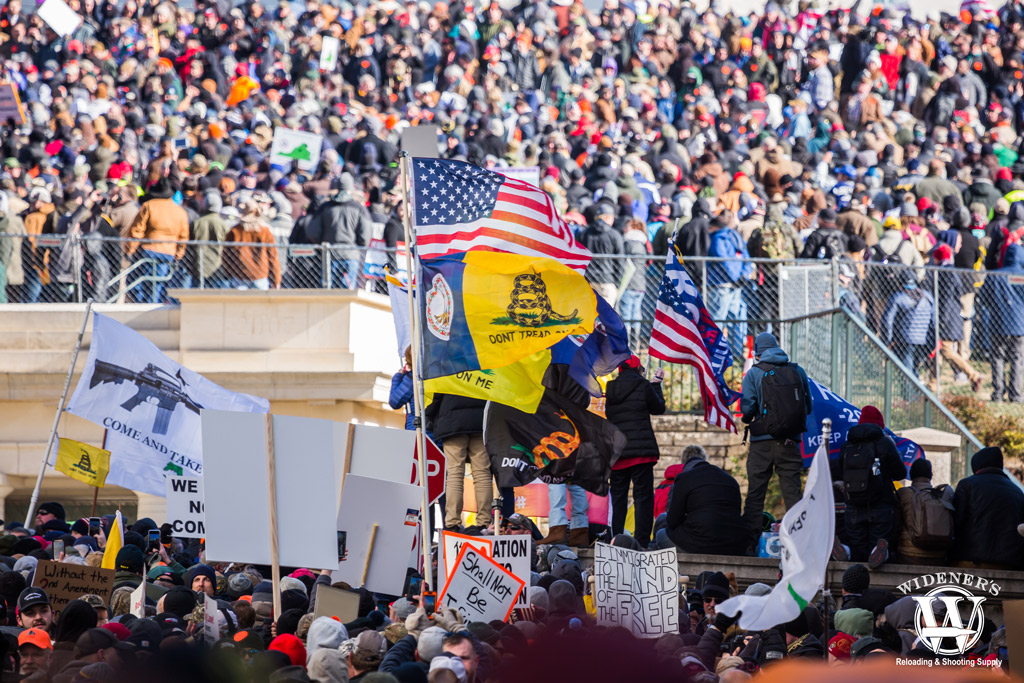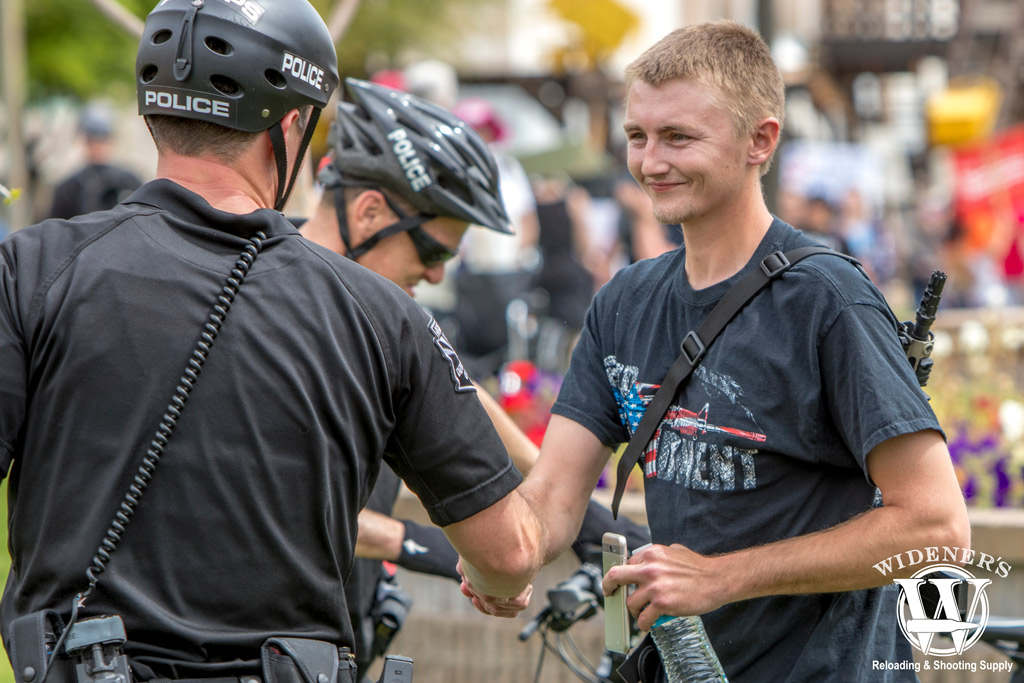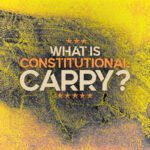

There’s a lot of political discussion going on these days about open carrying laws and firearm permits in general. But all the terminology can be really confusing. What exactly constitutes open carry, and why are so many political advocates arguing about it?
This article isn’t meant to sway your opinion in any way or get into the weeds of legal terminology. Instead, it’ll break down exactly what open carry means in the context of the ongoing gun law discussion, as well as describe where openly carrying a firearm is currently legal or restricted.
What Exactly Is Open Carry?
“Open carry” refers to openly carrying a firearm in public, where it isn’t noticeably hidden from average or “common” observation. In other words, if it’s obvious that you’re armed, you’re practicing open carry.
Naturally, states have a wide range of laws in place to determine whether it’s legal to openly carry a firearm in public, as well as whether you need a license to do so. Some people prefer to practice open carry in an attempt to deter engagement with criminals. Others prefer open carrying as it often makes their firearm easier to retrieve in a dangerous situation compared to many concealed carry holsters (which are, by their very nature, worn underneath clothing or in pockets).
There’s a lot of debate surrounding open carry these days, but its true definition is most important to understand. Open carry is not merely having a firearm within reach, nor does it count if your firearm is visible in your own home.
All states allow you to own a gun with a permit or license on your own property. Furthermore, many states allow you to openly carry your firearm on your property within certain limits. Open carry only applies if you take the weapon into a public space and have it visible to everyone around you.
Open Carry Laws

The four broad types of open carry laws are permissive, licensed, anomalous, and non-permissive.
As mentioned, states have a variety of different open carry laws depending on the opinions of their people and the attitudes of their state legislatures. There are four broad types of open carry laws that can apply depending on where you live.
Permissive Open Carry
States with permissive open carry laws allow any adult to openly carry a firearm without a permit or license. In most cases, these laws apply to handguns only, although some states allow you to openly carry rifles or larger weapons without permits or licenses as well. The states that allow you to openly carry your firearms without a permit include:
- Alabama
- Alaska
- Arizona
- Arkansas
- Delaware
- Idaho
- Kansas
- Kentucky
- Louisiana
- Maine
- Massachusetts
- Mississippi
- Montana
- Nevada
- New Hampshire
- New Mexico
- Ohio
- Oklahoma
- Pennsylvania
- South Dakota
- Vermont
- Virginia
- Washington
- West Virginia
- Wisconsin
- Wyoming
However, note that many of these states do require you to have a license for a rifle or for certain types of shotgun weapons. In general, it’s best to assume that any permissive open carry states only allow you to openly carry with handguns until you read a given state’s laws regarding the issue.
Licensed Open Carry

In states with licensed carry laws, gun owners can openly carry with a valid permit.
Other states have licensed open carry laws. These allow any gun owner to carry their firearms openly after they are issued an official license or permit. However, these states include those with laws that do not allow you to specifically open carry per related state statutes, but they still require you to have a permit or license to carry a handgun in the first place.
In these states, you may or may not be stopped by law enforcement officers depending on local jurisdictions or counties, which may have their own laws concerning the practice of open carrying. For example, Rhode Island requires you to have a permit to own a handgun in the first place, and you can only openly carry if you have a permit issued by the Attorney General, which generally excludes members of the public in favor of law-enforcement officers.
On the flip side, New Jersey and New York both allow you to own handguns provided you have a permit or license, but you can’t usually openly carry except in very specific circumstances or locations. States with licensed open carry laws include:
- Texas
- Georgia
- Tennessee
- Indiana
- Iowa
- Utah
- Minnesota
- North Dakota
- Michigan
- New York
- New Jersey
- Maryland
- Rhode Island
- Connecticut
Anomalous Open Carry
Some states have particularly complex laws regarding open carrying. In a nutshell, they have so-called “anomalous” open carry laws, which means that carrying your firearm openly can be either legal or illegal under state law. However, local governments sometimes have provisions that allow their gun laws to differ from those of the state government, as in the cases of California and Colorado.
This doesn’t necessarily mean you can open carry anywhere you like. In fact, it means just the opposite! If you plan to open carry in these states, you need to do your research beforehand and make sure that any counties or law enforcement jurisdictions you plan to spend time in permit open carrying either entirely or under certain circumstances.
Furthermore, it can sometimes be risky to open carry in these states as any federal officers in those states will be obligated to obey federal law or the laws of local state government, not local counties.
States with anomalous open carry laws include:
- North Carolina
- Missouri
- Nebraska
- Colorado
- Oregon
Non-Permissive Open Carry
Lastly, some states have outright banned open carrying your firearm under any circumstances. You can only own a firearm with specific permits and with a concealed carrying license. These states include:
- Florida
- California
- Illinois
- South Carolina
Additionally, certain cities or metropolitan districts have banned open carrying under all circumstances. These are New York City and Washington DC. In these areas, you cannot open carry your firearm at all, and getting a firearm can be very difficult in the first place.
What Is “Brandishing” A Gun?
It’s important to recognize that openly carrying a firearm is not the same thing as brandishing a weapon and that brandishing can be a serious crime even in states with permissive open carrying laws.
According to most state legislatures, “brandishing” your firearm means carrying your firearm directly in your hands, and especially if you hold a firearm in a firing position or in a combat stance. Brandishing your firearm can result in police arresting you and taking away your license, if applicable.
These laws are in place to limit the possibility of accidents and to prevent people from using their firearms casually in public places. The law is extremely gray in this area – some police officers may accuse you of brandishing your firearm if your hand goes near the handle of a weapon at any point, for instance.
Because of this, it’s wise to remember that as soon as your hands touch your weapon in any capacity, it may constitute brandishing depending on the situation and other contextual elements.
Handguns VS Rifles/Shotguns

Depending on the state you live in, certain restrictions may apply when openly carrying a long gun.
In addition to all the laws surrounding open carrying in general, you also have to keep in mind that laws can be different when it comes to long guns like rifles and shotguns. For example, 44 states currently allow you to open carry a long gun under certain circumstances, like hunting expeditions or while you’re on your property.
Other states, including Utah, Tennessee, and Iowa, require your long gun to be unloaded at all times if you are openly carrying it. For long weapons, open carrying means having the rifle visible and on your person, such as slung over your shoulder or across your back. Technically, your firearm being visible in the cabin of your vehicle can also count as openly carrying.
Certain states, like Pennsylvania and Virginia, only allow you to openly carry long guns in certain cities. Then there are also states that outright prohibit openly carrying long guns under any circumstances, including California, Florida, Illinois, Massachusetts, New Jersey, Minnesota, and the District of Columbia.
Can Openly Carried Guns Be Loaded?
There’s one more big aspect of open carry laws to keep in mind: whether the firearm is loaded with ammo. In a lot of cases, states that may otherwise be relatively permissive with their open carrying laws will restrict carrying loaded firearms.
To further complicate matters, what constitutes “loaded” can vary from place to place as well. Some states qualify any firearm with a loaded magazine as fully loaded, while others include firearms with ammunition close at hand as “loaded”.
For example, Nebraska generally allows open carry without permits, except in Omaha. In Omaha, residents and visitors cannot openly carry firearms if they are loaded.
Nevada is another good example. It allows open carry without permits, with the exception of some local restrictions. But you can never carry a loaded long gun in a vehicle.
All this is to say that you should always look up the specific laws for any state or major city you plan to visit. Local restrictions, legal intricacies, and the attitudes of the public can all play a role in whether open carry is legal, restricted, or some mixture of the two.
As you can see, open carrying is a complex subject. Hopefully, we’ve broken down the topic so it’s a little more understandable!


